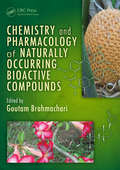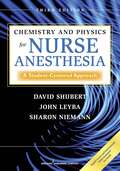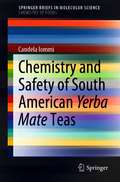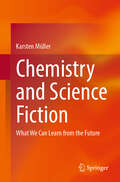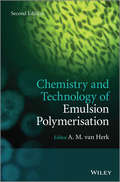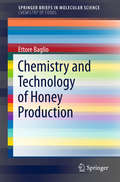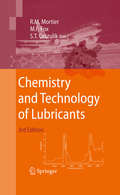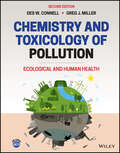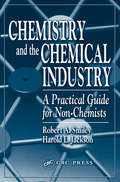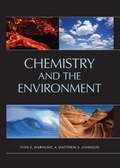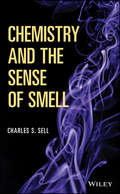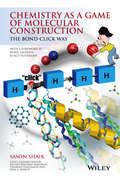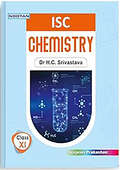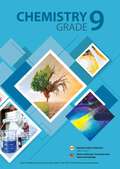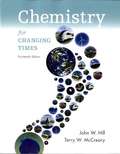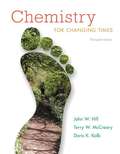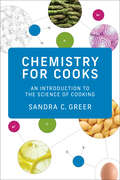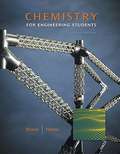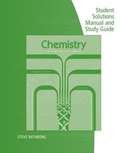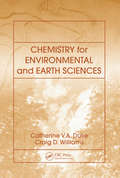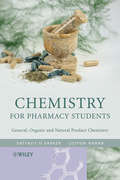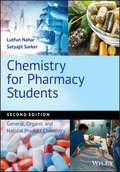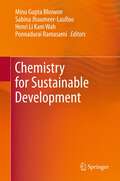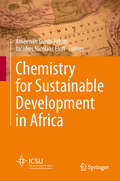- Table View
- List View
Chemistry and Pharmacology of Naturally Occurring Bioactive Compounds
by Bruce A. MoyerNatural products play crucial roles in modern drug development, and constitute a prolific source of novel lead compounds or pharmacophores for ongoing drug discovery programs. Chemistry and Pharmacology of Naturally Occurring Bioactive Compounds presents cutting-edge research in the chemistry of bioactive natural products and demonstrates how natur
Chemistry and Physics for Nurse Anesthesia: A Student-Centered Approach
by David Shubert John Leyba Sharon NiemannWith a focus on chemistry and physics content that is directly relevant to the practice of anesthesia, this text--written in an engaging, conversational style--supplies all the scientific information required for the combined chemistry and physics course for nurse anesthesia students. Now in its third edition, the text is updated and reorganized to facilitate a greater ease and depth of understanding. The addition of a third author--a practicing nurse anesthetist--enhances the clinical relevance of the scientific information. Clinical scenarios now begin every chapter, and a concluding chapter, new to this edition, provides detailed, step-by-step solutions to the book's review questions. Also included is a comprehensive list of need-to-know equations. <P><P>The third edition retains the many outstanding learning features from earlier editions, including a special focus on gases, the use of illustrations to demonstrate how scientific concepts relate directly to their clinical application in anesthesia, and end-of-chapter summaries and review questions to facilitate self-assessment. Fifteen online videos enhance teaching and learning, and abundant clinical application scenarios help reinforce scientific principles and relate them to day-to-day anesthesia procedures. This clear, easy-to-read text will help even the most chemistry- and physics-phobic students to master the foundations of these sciences and competently apply them in a variety of clinical situations.
Chemistry and Safety of South American Yerba Mate Teas (SpringerBriefs in Molecular Science)
by Candela IommiThis book explores the traditional use of Ilex paraguariensis, a plant that is widely distributed in South America. Thanks to its purported properties, it has been used for centuries in the form of teas with a variety of names, including: ‘yerba mate’ (Argentina), ‘chimarrão’ (Brazil), and others. Ilex paraguariensis and its teas (also referred to as ‘mate teas’) are well known because of their alleged pharmacological effects in numerous common conditions, including obesity, osteoporosis, constipation, arthritis, and hypertension. These effects are generally ascribed to yerba mate teas because the botanical species contains bioactive and stimulating substances like caffeine (originally dubbed ‘mateine’), various alkaloids, and several phenolic acids. Interestingly, the chemical profiles of these teas can fluctuate over time, creating serious production problems. As a result, it is difficult to reliably determine their safety and health effects on humans. In response to the global interest in these products, this book offers a reference guide to ‘yerba mate’/‘chimarrão’ teas. It analyzes their chemical profiles, discusses their bioactive features, and addresses their safety and health effects. In addition, since the cultural heritage of yerba mate has greatly contributed to its international success, the book also provides information on its historical legacy, regulatory aspects, and the global market.
Chemistry and Science Fiction: What We Can Learn from the Future
by Karsten MüllerThis book aims to introduce students (and other interested laypeople) to chemistry in a fun way, using examples from science fiction. The individual chapters are deliberately kept short to enhance readability. The book can especially be used as supplementary reading for lectures in chemistry and related disciplines.
Chemistry and Technology of Emulsion Polymerisation
by A. M. van HerkChemistry and Technology of Emulsion Polymerisation 2e provides a practical and intuitive explanation of emulsion polymerization, in combination with both conventional and controlled radical polymerization. For those working in industry, coupling theory with everyday practice can be difficult. By carefully explaining the principles of the reaction, based on well-designed experimental investigation, the book explains how the principles relate to practical application.The second edition of this book includes a new chapter on morphology of latex particles, a rapidly progressing area where modelling the thermodynamic and kinetic aspects of phase separation and morphology has developed into a mature and powerful tool to predict and control morphology of latex particles. Another area that is rapidly progressing is the application of controlled radical polymerisation in emulsion polymerization. Controlled radical polymerisation is used in aiding encapsulation of inorganic particles like pigment particles and clay platelets. These latest developments are included in the second edition.
Chemistry and Technology of Honey Production (SpringerBriefs in Molecular Science)
by Ettore BaglioThis Brief explains and discusses honey and its production from a chemical perspective. It outlines why honey is a special and unique food, being produced by bees from the nectar of plants or from secretions of living parts of plants. Although glucose and fructose are the main constituents of honey, its overall composition is far from being simple or uniform: other substances such as organic acids, enzymes, or minerals are found in varying amounts. In this Brief, the author addresses the factors that influence the composition of the honey as well as the consequences that the composition has on properties such as color, crystallization, density, viscosity, or the refractive index. This Brief also introduces some of the most commonly used quality parameters for the determination of ageing and/or overheating: 5-hydroxymethylfurfural (HMF) and diastase. Other recently proposed constituents for quality parameters are also mentioned, e. g. 1,2 dicarbonyl compounds (3 deoxyglucosone, methylglyoxal, glyoxal) and furosine, also named 2-furoylmethyl lysine.
Chemistry and Technology of Lubricants
by Malcolm F. Fox Stefan T. Orszulik Roy M. Mortier"Chemistry and Technology of Lubricants" describes the chemistry and technology of base oils, additives and applications of liquid lubricants. This Third Edition reflects how the chemistry and technology of lubricants has developed since the First Edition was published in 1992. The acceleration of performance development in the past 35 years has been as significant as in the previous century: Refinery processes have become more precise in defining the physical and chemical properties of higher quality mineral base oils. New and existing additives have improved performance through enhanced understanding of their action. Specification and testing of lubricants has become more focused and rigorous. "Chemistry and Technology of Lubricants" is directed principally at those working in the lubricants industry as well as individuals working within academia seeking a chemist's viewpoint of lubrication. It is also of value to engineers and technologists requiring a more fundamental understanding of the subject.
Chemistry and Toxicology of Pollution: Ecological and Human Health
by Des W. Connell Gregory J. MillerDescribes the transport of pollutants through the environment and their impact on natural and human systems, fully updated to cover key topics in modern pollution science Chemistry and Toxicology of Pollution examines the interactions and adverse effects of pollution on both natural ecosystems and human health, addressing chemical, toxicological, and ecological factors at both the regional and global scale. The book is written using a conceptual framework that follows the interaction of a pollutant with the environment from distribution in the various abiotic sectors of the environment to exposure and effects on individuals and ecosystems. The authors also highlight the critical role of various socio-economic, political, and cultural aspects in achieving sustainable goals, strategies, and science-based solutions to pollution and health. This comprehensive volume covers the chemical behavior and governing principles of pollutants, their interactions with humans and ecosystems, and the methods and processes of environmental risk assessment and pollution management. Extensively revised and expanded, the second edition equips readers with the knowledge required to help lead the way towards a healthy and sustainable future. New chapters address current pollution issues such as global warming and climate change, recent advances in environmental science, the monitoring and evaluation of new and emerging pollutants, risk assessment and remediation, and innovative pollution management approaches and techniques. With in-depth material on human toxicology integrated throughout the text, Chemistry and Toxicology of Pollution: Provides an effective framework for interpreting the information produced by international, national, and local agencies Presents unifying theories and principles supported by up-to-date scientific literature Offers broad coverage of pollution science with an emphasis on North America, the UK, Europe, China, India, and Australia Discusses the similarities and differences of the impact of pollutants on the natural environment and humans Chemistry and Toxicology of Pollution, Second Edition enables readers to view pollution in its correct perspective and develop appropriate control measures. It is essential reading for scientists, academic researchers, policymakers, professionals working in industry, and advanced students in need of a clear understanding of the nature and effects of environmental pollution.
Chemistry and the Chemical Industry: A Practical Guide for Non-Chemists
by Robert A. Smiley Harold L. JacksonAs chemical companies strive to be more competitive in the world economy, it is essential that their employees, including sales and marketing personnel, as well as administrative support groups understand the basic concepts of the science upon which the industry is based. The authors, who have over 100 years of combined experience in the chemical i
Chemistry and the Environment
by Sven E. Harnung Matthew S. JohnsonThis textbook presents the chemistry of the environment using the full strength of physical, inorganic, and organic chemistry, in addition to the necessary mathematics and physics. It provides a broad yet thorough description of the environment and the environmental impact of human activity using scientific principles. It gives an accessible account while paying attention to the fundamental basis of the science, showing derivations of formulas and giving primary references and historical insight. The authors make consistent use of professionally accepted nomenclature (IUPAC and SI), allowing transparent access to the material by students and scientists from other fields. This textbook has been developed through many years of feedback from students and colleagues. It includes more than 400 online student exercises that have been class tested and refined. The book will be invaluable in environmental chemistry courses for advanced undergraduate and graduate students and professionals in chemistry and allied fields.
Chemistry and the Sense of Smell
by Charles S. Sell“I cannot recommend this fascinating book highly enough.” –Simon Cotton, Chemistry & Industry, September 2014 “In conclusion: A comprehensive introduction to the world of odours, not only for chemists.” –review in German: Monika Paduch, Gefahrstoffe - Reinhaltung Luft, October 2014 A comprehensive overview of fragrance chemistry Fragrance materials are universal, from personal care products to household cleaners, laundry products, and more. Although many of the scents themselves are synthesized in a lab, the actual mechanism of odour has long baffled chemists who attempt to model it for research. In Chemistry and the Sense of Smell, industry chemist Charles S. Sell explores the chemistry and biology surrounding the human detection and processing of odour, providing a comprehensive, single-volume guide to the totality of fragrance chemistry. The correlation between molecular structure and odour is much more complex than initially thought, and the intricacies of the mechanism by which the brain interprets scent signals leaves much to be discovered. This book provides a solid foundation of fragrance chemistry and highlights the relationship between research and industry with topics such as: The analysis and characterization of odour The role scent plays in our lives The design and manufacture of new fragrance ingredients The relationship between molecular structure and odour The mechanism of olfaction Intellectual challenges and the future of the field Complete with illustrations that clarify difficult concepts and the structures of the molecules under discussion, Chemistry and the Sense of Smell is an all-inclusive guide to the science of scent. For professionals in the fragrance industry or related fields, this book is one resource that should not be overlooked.
Chemistry as a Game of Molecular Construction
by Roald Hoffmann Sason Shaik Racheli Ben-Knaz Wakshlak Dina A. Sharon Usharani DandamudiThe proposed textbook takes the students into a fascinating journey that shows the universal aspect of chemistry: Chemistry is the window given to mankind to glimpse into his material-chemical essence and come to terms with its limitations. In the introductory chapter/lecture, the textbook discusses the connection between the "chemical matter" and love, sex, depression, addiction--all the properties we call "human". As we are made of chemical matter, this chapter makes a point why knowledge of chemistry is so essential to mankind. This preamble is followed by about 14 short chapters/lectures, which introduce chemistry as molecule building process, like a game of Lego.
Chemistry class 11 - ISCE
by Dr H. C. SrivastavaThe thoroughly revised and restructured ISC Chemistry for Class XI aligns with the latest syllabus issued by the Council for Indian School Certificate Examination, New Delhi. It now closely mirrors the NCERT syllabus, ensuring comprehensive coverage. Each unit concludes with NCERT Textbook Exercises, supplemented by necessary hints and solutions, facilitating better understanding and practice for students. This structured approach aims to provide a clear and concise learning experience, adhering to the updated curriculum requirements.
Chemistry class 9 - MIE
by Mauritius Institute of EducationThe Grade 9 Chemistry textbook published by the Mauritius Institute of Education in 2023 covers five comprehensive units designed to provide students with a foundational understanding of key chemical concepts. Unit C1 delves into the composition of air, exploring topics like the greenhouse effect, global warming, and pollution, while also suggesting measures for environmental protection. Unit C2 focuses on mixtures and separation techniques, introducing methods like sublimation and crystallization. Unit C3 teaches the language of chemistry, encompassing symbols, valencies, and chemical equations. Unit C4 explores the properties and reactions of metals, introducing the reactivity series and displacement reactions. Finally, Unit C5 delves into the formation, classification, and properties of salts, including common examples. Each unit is rich with activities, diagrams, tables, and exercises to engage students and foster their understanding of these fundamental chemistry concepts.
Chemistry for Changing Times
by John W. Hill Terry W. MccrearyFor non-majors introductory chemistry courses. Make chemistry relatable to all students. Chemistry for Changing Times has defined the liberal arts chemistry course and remains the most visually appealing and readable introduction to the subject. The Fourteenth Edition increases its focus on environmental and other relatable issues with revised green chemistry essays throughout and new Chemistry at Home experiments, both in the text and in MasteringChemistry. Abundant applications and examples fill each chapter and enable students of varied majors to relate to the content more readily. Updated material throughout reflects the latest scientific developments in the field demonstrating the relevance of chemistry to all students.
Chemistry for Changing Times (13th Edition)
by John W. Hill Doris K. Kolb Terry W. McCrearyThe book that defined the liberal arts chemistry course, Chemistry for Changing Times remains the most visually appealing and readable introduction on the subject. The Thirteenth Edition increases its focus on student engagement – with revised “Have You Ever Wondered?” questions, new Learning Objectives in each chapter linked to end of chapter problems, and new Green Chemistry content, closely integrated with the text. Abundant applications and examples fill each chapter, and material is updated throughout to mirror the latest scientific developments in a fast-changing world. Compelling chapter opening photos, a focus on Green Chemistry, and the “It DOES Matter” features highlight current events and enable students to relate to the book more readily.
Chemistry for Christian Schools
by Thomas E. Porch Heather E. Cox John S. WetzelChemistry for Christian Schools- in addition to having problems in abundance for student practice, also talks about the history of chemistry and about many ways that Christianity and chemistry are related.
Chemistry for Cooks: An Introduction to the Science of Cooking
by Sandra C. GreerA fun approach to teaching science that uses cooking to demonstrate principles of chemistry for undergraduate students who are not science majors, high school students, culinary students, and home cooks.How does an armload of groceries turn into a culinary masterpiece? In this highly accessible and informative text, Sandra C. Greer takes students into the kitchen to show how chemistry—with a dash of biology and physics—explains what happens when we cook. Chemistry for Cooks provides all the background material necessary for nonscientists to understand essential chemical processes and to see cooking as an enjoyable application of science. Greer uses a variety of practical examples, including recipes, to instruct readers on the molecular structure of food, the chemical reactions used in cooking to change the nature of food, and the essentials of nutrition and taste. She also offers kitchen hints and exercises based on the material in each chapter, plus do-it-yourself projects to encourage exploration of the chemistry that takes place when we cook food. FeaturesPerfect for science courses aimed at non–science majors: does not require prior knowledge of chemistry, physics, or biologyEqually useful for general readers, home and professional cooks, and culinary studentsTopics include what matter is made of, how the structure of matter is altered by heat, how we treat food in order to change its microscopic structure, why particular procedures or methods are used in the kitchen, and how to think critically about various cooking methodsA reference section at the end of each chapter points readers to resources for further studyAdditional online resources include a solutions manual, a sample syllabus, and PowerPoint slides of all tables and figures
Chemistry for Engineering Students (Second Edition)
by Lawrence S. Brown Thomas A. HolmeEnhanced with a remarkable number of new problems and applications, the Second Edition of CHEMISTRY FOR ENGINEERING STUDENTS provides a concise, thorough, and relevant introduction to chemistry that prepares students for further study in any engineering field.
Chemistry for Engineering Students: Student Solutions and Study Guide
by Lawrence S. Brown Thomas A. Holme Steve RathboneThe STUDENT SOLUTIONS MANUAL AND STUDY GUIDE provides students with a comprehensive guide to working the solutions to the odd-numbered end-of-chapter problems in the text and also includes each chapter's Study Goals and Chapter Objective quizzes. Because the best way for students to learn and understand the concepts is to work multiple, relevant problems on a daily basis and to have reinforcement of important topics and concepts from the book, the STUDENT SOLUTIONS MANUAL gives students instant feedback by providing not only the answers to problems, but also detailed explanations of each problem's solution.
Chemistry for Environmental and Earth Sciences
by Catherine Vanessa Duke Craig Denver WilliamsChemistry for Environmental and Earth Sciences focuses on the chemistry and processes behind environmental issues such as global warming, ozone depletion, acid rain, water pollution, and soil contamination. Accessible to science as well as non-science majors, this textbook is divided into four intuitive chapters: Fire, Earth, Water, and Air. It uses worked examples and case studies drawn from current applications along with clear diagrams and concise explanations to illustrate the relevance of chemistry to geosciences. In-text and end-of-chapter questions with complete solutions also help students gain confidence in applying concepts from this book towards solving current, real-world problems.
Chemistry for Pharmacy Students
by Lutfun Nahar Satyajit Sarker"This book has succeeded in covering the basic chemistry essentials required by the pharmaceutical science student... the undergraduate reader, be they chemist, biologist or pharmacist will find this an interesting and valuable read." -Journal of Chemical Biology, May 2009Chemistry for Pharmacy Students is a student-friendly introduction to the key areas of chemistry required by all pharmacy and pharmaceutical science students. The book provides a comprehensive overview of the various areas of general, organic and natural products chemistry (in relation to drug molecules).Clearly structured to enhance student understanding, the book is divided into six clear sections. The book opens with an overview of general aspects of chemistry and their importance to modern life, with particular emphasis on medicinal applications. The text then moves on to a discussion of the concepts of atomic structure and bonding and the fundamentals of stereochemistry and their significance to pharmacy- in relation to drug action and toxicity. Various aspects of aliphatic, aromatic and heterocyclic chemistry and their pharmaceutical importance are then covered with final chapters looking at organic reactions and their applications to drug discovery and development and natural products chemistry.accessible introduction to the key areas of chemistry required for all pharmacy degree coursesstudent-friendly and written at a level suitable for non-chemistry studentsincludes learning objectives at the beginning of each chapterfocuses on the physical properties and actions of drug molecules
Chemistry for Pharmacy Students: General, Organic and Natural Product Chemistry
by Lutfun Nahar Satyajit SarkerIntroduces the key areas of chemistry required for all pharmacy degree courses and focuses on the properties and actions of drug molecules This new edition provides a clear and comprehensive overview of the various areas of general, organic, and natural products chemistry (in relation to drug molecules). Structured to enhance student understanding, it places great emphasis on the applications of key theoretical aspects of chemistry required by all pharmacy and pharmaceutical science students. This second edition particularly caters for the chemistry requirements in any ‘Integrated Pharmacy Curricula’, where science in general is meant to be taught ‘not in isolation’, but together with, and as a part of, other practice and clinical elements of the course. Chemistry for Pharmacy Students: General, Organic and Natural Product Chemistry, 2nd Edition is divided into eight chapters. It opens with an overview of the general aspects of chemistry and their importance to modern life, with emphasis on medicinal applications. The text then moves on to discuss the concepts of atomic structure and bonding and the fundamentals of stereochemistry and their significance to pharmacy in relation to drug action and toxicity. Various aspects of organic functional groups, organic reactions, heterocyclic chemistry, nucleic acids and their pharmaceutical importance are then covered in subsequent chapters, with the final chapter dealing with drug discovery and development, and natural product chemistry. Provides a student-friendly introduction to the main areas of chemistry required by pharmacy degree courses Written at a level suitable for non-chemistry students in pharmacy, but also relevant to those in life sciences, food science, and the health sciences Includes learning objectives at the beginning of each chapter Focuses on the physical properties and actions of drug molecules Chemistry for Pharmacy Students: General, Organic and Natural Product Chemistry, 2nd Edition is an essential book for pharmacy undergraduate students, and a helpful resource for those studying other subject areas within pharmaceutical sciences, biomedical sciences, cosmetic science, food sciences, and health and life sciences.
Chemistry for Sustainable Development
by Henri Li Kam Wah Ponnadurai Ramasami Minu Gupta Bhowon Sabina Jhaumeer-LaullooChemistry for Sustainable Development is a collection of selected papers by the participants of the International Conference on Pure and Applied Chemistry (ICPAC 2010) on the theme of "Chemistry for Sustainable Development" held in Mauritius in July 2010. In light of the significant progresses and challenges in the development and implementation of green and sustainable chemistry, this volume reviews the recent results generated by a more efficient use of resources to minimize carbon footprints, to foster the eradication or minimisation of solvent use in chemistry, and to deliver processes which lead to increased harmony between chemistry and the environment. Chemistry for Sustainable Development is written for graduates, postgraduates, researchers in industry and academia who have an interest in the fields ranging from fundamental to applied chemistry.
Chemistry for Sustainable Development in Africa
by Ameenah Gurib-Fakim Jacobus Nicolaas EloffChemistry for Sustainable Development in Africa gives an insight into current Chemical research in Africa. It is edited and written by distinguished African scientists and includes contributions from Chemists from Northern, Southern, Western, Eastern, Central and Island state African Countries. The core themes embrace the most pressing issues of our time, including Environmental Chemistry, Renewable Energies, Health and Human Well-Being, Food and Nutrition, and Bioprospecting and Commercial Development. This book is invaluable for teaching and research institutes in Africa and worldwide, private sector entities dealing with natural products from Africa, as well as policy and decision-making bodies and non-governmental organizations.
